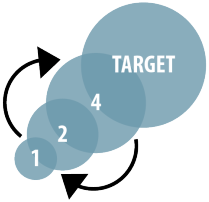Innovate like Apple
Digital transformation, Internet of Things, hyper-converged and hyper-scale, the software defined everything, desired state automation, infra-as-a-code: just a few of the topics that today’s Chief Information Officer has to deal with. It all comes down to continuous innovation within the IT domain. Standing still is not an option, and innovation is a fact rather than a choice. So it is important to integrate innovation on a daily basis in your team and thus incorporate it into your business culture.
The word 'innovation' might suggest groundbreaking new concepts like the Leonardo Da Vinci inventions, the invention of the first Apple and the introduction of the Uber model – that single ‘aha’ moment that could change the world forever. But this is not the type of innovation you want to integrate in your team. In your team you want a focus on small changes, and on a continuous process of innovation on a daily basis: a mindset, in other words.
4-2-1 method
 Finding an easy start/stop button is key. Ensure that the innovations are small and have a short cycle. Think up small use cases and play with the technology in a deep dive. To do this, we use our “4-2-1 method”: naming a tangible result that you want to have ready in 4 weeks – and planning which actions you need to have finalized in 2 weeks and which you need to start up already (in 1 week) in order to achieve this.
Finding an easy start/stop button is key. Ensure that the innovations are small and have a short cycle. Think up small use cases and play with the technology in a deep dive. To do this, we use our “4-2-1 method”: naming a tangible result that you want to have ready in 4 weeks – and planning which actions you need to have finalized in 2 weeks and which you need to start up already (in 1 week) in order to achieve this.
Then you can follow these actions through a progress trail, communicating your actions and progress concisely using bullet points. It is also important to zoom in and out, implement a simple and general way of creating illustrations.
Drive for innovation
Innovation takes energy – so a little external pressure (from a customer or project) is sometimes no bad thing. Bringing a new product to market goes faster if you already have a first pilot customer to whom you have to deliver. But even more important than external pressure is internal focus. The climate is conducive to innovation only if the top level of your company is concerned with content.
Apple would never have been so innovative if Steve Jobs had not kept an eye on every detail and had an opinion about every aspect of content. ASML would never have invented the EUV machine if the CEO and the whole management had not been involved in the content of developments and with R&D.
Role for the CIO?
If there is enough content-based focus on innovation from the top, then it is key that the CIO takes on the executive role. We are not Apple, so keep it small and innovate in small steps. After all, taking one step ahead is also an innovation. Use the data from your IT processes in setting up analytics and obtaining operating information. This allows you to drive automation with desired state tooling.






